Luxor West Bank
Starting at 8 today to try to avoid the crowds and the heat — even in Spring, it’s oppressive on the west bank. The sandstone cliffs are like oven stones and catch and reflect the heat back into the valleys. The breeze is nice, though.
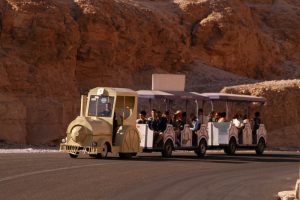
We decided to swap around things today, to spend the day on the west bank and spend a more leisurely day on the eastern bank and the temples tomorrow. It made much more sense. We had a new guide today, Jimmy had to stay at home with his family. Haggag is very interesting — probably the best guide that we had — and his specialty is the religious aspects of the tombs. He’s working on his PhD, and he studied in Pennsylvania.
Valley of the Queens
Only four tombs are open in the Valley of the Queens, and most of them are for princes. Earlier pharaohs and their families were buried here. Some 100 tombs are cut into the stone walls here — Listing of Tombs. We went into two of the tombs, including Amunherkhopshef. We didn’t take a lot of pictures here, I’m not sure why.
Valley of the Kings
Our next stop is the Valley of the Kings — not the most impressive of places when seen from the road — just a few walls and holes in the ground. The gate and ticket kiosk are far down the road (part of the new security measures) and you take a little Disneyland train (called a Tuff Tuff) to get closer to the actual barrier. It beats walking up the road for a mile or so.
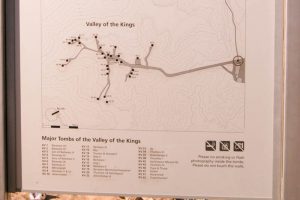
The tombs are built under natural pyramids — while they no longer build “real” pyramids because they are like beacons to thieves, they still want the symbolism of “first land” to rise from the waters. First land is simply mountains — pyramids — rising from the sea, part of the Geb/Sed myth.
In the tombs, Re, the sun god, is represented by many symbols, all of them the “circle of life”. Shown as the scarab at dawn, a disk at noon, and old man at dusk. In the calendar, there are 360 days (12 months of 30 days of 3-10 day weeks) plus five “Forgetting Days” of festivals, celebrating the honeymoon of Re and Isis. The tombs in the valleys symbolize the journey to the second life, not the “Afterlife”.
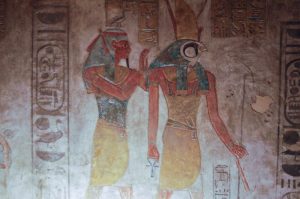
Life is on the east — houses and temples to the gods, all the living world. Death is on the west — funerary temples and tombs only. But, the egyptians really didn’t have a concept of “death” since it was simply a second life.
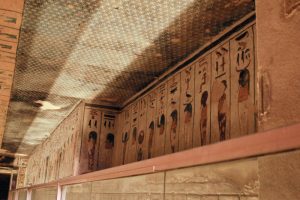
I was very surprised by the first tomb we visited. Wow. I say that alot, actually, but I wasn’t prepared for the bright colors and the sheer volume of art in the stone tombs. These tombs are actually large — deep, with multiple rooms, and gorgeously colored. Tausert, Ramesses III, Ramesses IX, Seti II, Merenptah, and Thutmosis III — I took one look at the huge staircase up o the mountain cleft and the thought that it was 90 feet back down was a bit too daunting. I sat on the rock wall and waited for Mark. The style of this tomb (much like Amenhotep) is very different from the styles of the others. I’m sorry I missed it., but Mark took some good pictures.
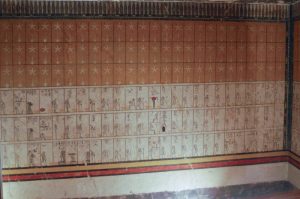
The famous tomb KV5 is not open. This is the enormous tomb of Ramesses II’s sons (possibly the largest tomb in the valley with hundreds of rooms). It is a current excavation, so no visitors. Most tombs are empty, anyway — some retain a sarcophagus or fragments of one, but they are empty rooms. It’s the decorations that are fascinating now.
We passed on seeing King Tut’s tomb — it is pronounced toot-ANKH-AH’-moon, not Toot’n’KA’mun according to our guide) since everything in he tomb is in the Egyptian Museum, so other than to see how small it is compared to the others, there isn’t much there. Instead of Tut, we went to three more tombs and to the Valley of the Workers, a much better choice.
Valley of the Workers
Then to the Valley of the Workers/Artists, which is the village (of about 1000) who supplied the technical skills to build and decorate the tombs. The houses — one or two story mud brick and stone, are the same now as there were in 1700 BCE — the tombs are built just up the hills from the houses.
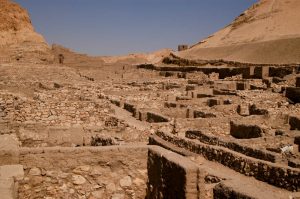
The artists were “protected” by guards to prevent anyone from coming in to the West Bank, or them leaving to the East — the workers knew where the tombs were and what was in them, so they were carefully guarded to make sure they didn’t reveal that information. It didn’t work — the tombs were looted soon after they were built, in what is widely believed to be inside jobs.
One of the workers, named Sennedjem, was the “best in Egypt at making KNEES”. It is reasonable to assume that others did hands, eyes, or other body parts as a specialty. Workers were organized into gangs, and were responsible for the left-hand side of the tomb, or the right-hand side. Many nobles have a title such as Overseer of the Right-Side gang. It was almost an assembly line process.

We visited the Tomb of Peshedu, a deep hole of a tomb, but the details of daily life in the painted burial chamber are beautiful. A helpful gentleman handed out squared of cardboard to fan ourselves (it’s bloody hot in these airless tombs) and pointed out the interesting scenes. No photos were allowed, as they’ve apparently had problems with flash. Pity, really, as they were lovely.
We also visited the lovely little temple of Deir el-Medina, which is surrounded by high, undulating mud brick wall. We weren’t allowed to go up the stairs — mostly because another group was there. We could have given the custodian a bit of baksheesh, I think, and been allowed up on the roof, but not all of us. Behind the temple is an enormous deep drainage hole that was the garbage dump of the town — where the town put their refuse, so this is where everything will be found. It’s a great place to dig.
Ramesseum

The Ramesseum, our next stop, is enormous. It’s an imposing temple surrounded by the now-familiar mud brick wall and row upon row of mud brick arched storage rooms, like silos, for a few acres behind the temple itself. Food for the whole city of Thebes for two years could be stored here.
The colossi of Ramesses II is here, an astounding size. Only the head and shoulder remain, but they are truly colossal. The toes of the feet, found in pieces around the front of the temple, are almost two feet long, and it is said that the entire statue is one piece of pink granite. This is the piece that Shelley’s poem is supposedly written about.
I met a traveler from an antique land
Who said: Two vast and trunkless legs of stone
Stand in the desert. Near them, on the sand,
Half-sunk a shattered visage lies, whose frown,
And wrinkled lip, and sneer of cold command,
Tell that its sculptor well those passions read,
Which yet survive, stamped on these lifeless tings,
The hand that mocked them, and the heart that fed,
And on the pedestal these words appear:
“My name is Ozymandias, King of Kings:
Look upon my works, ye Mighty, and despair!”
Nothing beside remains. Round the decay
Of that colossal wreck, boundless and bare
The lone and level sands stretch far away. — Shelley
There are “new” mud brick walls surrounding the temple grounds, but they cannot be differentiated from the “old” mud bricks walls without some effort. Nothing has changed.
Medinet Habu
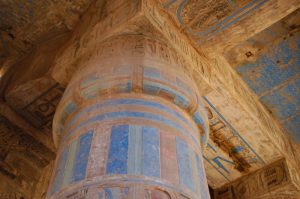
Very close by is the temple of Medinet Habu, a beautifully decorated ruin that we wandered around for an hour or so with our heads craned back staring at a the brilliantly colored ceiling. I think that this temple is actually even more colorful than Kom Ombo. I think that the temples are more likely to remain colorful if they are buried — most of these temples were engulfed in sand as little as a century ago.
Tombs of the Nobles
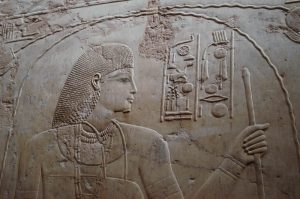
The Tombs of the Nobles — Ramose, Nakht, and Menna — are phenomenal. The bas-relief are incredibly detailed, carved into fine white limestone. It is nearly white and so smooth it feels like porcelain. Only some walls of the tombs are finished — the rest are gridded and outlined and barely started.
I was feeling very icky all day, upset stomach-food-poisoning sort of things (probably from Aswan, where I ate “Salad”. Even doused with lemon juice, it was apparently too much). So today included a series of stops to sit for a minute until the feeling passed. Still sickly even though we stopped for tea and lemon to settle my stomach, I sat in a hot bath once we got back to the hotel and then couldn’t seem to get warm. I bundled up in bed and Mark ordered room service to keep me company. He had steak, and ordered a plate of white rice for me. I ate in bed.